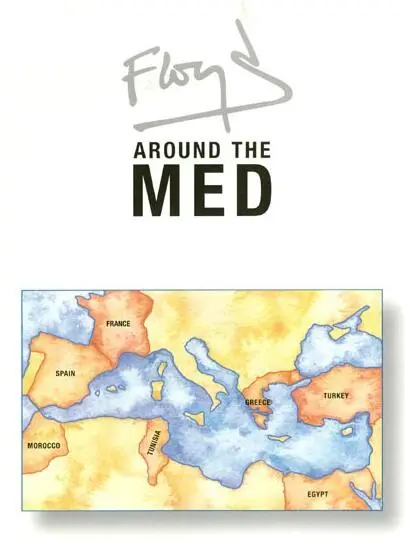Title Page
Introduction INTRODUCTION The primary flavours of the Mediterranean are olive oil, thyme, rosemary, basil, garlic and saffron. The main vegetables are aubergines, peppers, tomatoes and courgettes. All these are overlaid with a mist of lemon, nuts and spices from the East – nutmeg, cumin, cinnamon, cardamom, coriander, turmeric, chilli flakes, sea salt, black pepper, caraway and others. Rice, pasta, pulses and grains are preferred to the potato. Artichokes, spinach, celery leaves and mint are mixed with crunchy greens for salads. But the Mediterranean, which laps the shores of Europe, Asia and Africa, is populated by Christians, Arabs and Jews, by Latins and Moors, some meat eaters, some vegetarians, some pork lovers, and some nut lovers. Some of the countries are highly developed and have refrigerators and microwaves; others have simple clay pots with a few glowing embers of charcoal. Irrespective of creed, culture and cash, everyone shares a common love of food, whether it be fish, goat, lamb, pigeons and all manner of fowl, or fruit. The recipes in this book are authentic, although I have modified some. Many of them come from cooks who have never seen a television cookery show or read a cookery book. Indeed, many of them cannot read. They have never weighed or measured an ingredient in their lives, and may well time the cooking from the cockerel’s early-morning alarm call to the moment the shadow falls over the pigsty. As a consequence, these recipes require the reader to apply simple common sense to the quantities, the sizes of pots, the volume of liquid and the length of time things take to cook. Remember, this is not a workshop manual. Cooking is not a science. Cooking is a way of demonstrating your appreciation of nature and making a gift of kindness and love to those whose company you enjoy. And the love of good food, generosity and hospitality is central to the Mediterranean people’s way of life which, like olive oil, that indispensable liquid that flavours, cooks and heals, is as old as time and civilization, whether you are squatting on a rush mat in a hut on the banks of the River Nile or dining in the ornate splendour of Monte Carlo.
Greece Greece Mezze, moussaka & myths There is much more to Greek cooking than moussaka, stuffed vine leaves, greasy kebabs stuffed into pitta bread pockets with chips, salad and mayonnaise, and the ubiquitous Greek salad with a slab of feta cheese sprinkled with dried oregano. This may be what most of us encounter on our Greek holidays but if you search around a bit you will discover some very fine dishes indeed. Take the aubergine, for example. It’s essential in a moussaka but there’s much more to it than that. You could write a whole book about cooking aubergines the Greek way. They can be made into a wonderfully refreshing salad, or stuffed with minced mutton or lamb and roasted in the oven, or deep-fried in batter, or fried in olive oil and served cold with a marinade of lemon juice, finely chopped garlic and parsley, coriander, fennel or dill. Courgettes can be given the same agreeable treatment as aubergines, and vegetables à la grecque (cooked in a lemon and olive oil marinade) are really most enjoyable. Baby vegetables such as leeks, onions and artichoke hearts can all be cooked in the same way as mushrooms à la grecque. In Greece they love to cook with fresh herbs, such as coriander, dill, parsley, mint and spring onions, combined with lemon juice (I swear that Greek lemons produce some of the finest juice I have ever encountered). They like to use coriander seeds and cinnamon to flavour their dishes, and occasionally cumin. At its best, Greek cooking is light, refreshing, tasty and tangy – for example, lamb stewed with Cos lettuce or green peas, flavoured with a wonderful lemon sauce, is an exquisite dish. Stuffed vine leaves don’t have to be briny, vinegary things with congealed rice inside. Like cabbage leaves, they can be stuffed delightfully with a mixture of rice, fish or meat, maybe pine nuts, sultanas or currants.
Mezze, moussaka & myths
Chicken with lemons and raisins
Fricassée of spring Lamb
Mezze (Greek hors d'oeuvre)
Postcards from Greece
Sauté of spring lamb with apricots
Octopus
Ragout of octopus
Beef with green olives
Grilled fish with lemon sauce
Pasta rice with spinach
France
Toujours le garlic
Aubergine caviar
Fish soup
Provençal omelette cake
Postcards from France
Gratin of mussels
Sauté of new potatoes
Red mullet
Stuffed vegetables
Blanquette of vegetables
Turkey
Turkish delight?
Stuffed fish baked in filo pastry
Floyds turkish barbecue
Sauté of chicken
Minced beef and spinach
Spain
Lunch in the afternoon
Catalan broad bean salad
Red peppers stuffed wih salt cod purée
Partridges cooked in vinegar
Moorish Andalusian endive salad
Black pudding and sausages with almonds
Casserole of vegetables
Lobster in chocolate sauce
Grilled sardines
Tinto verano
Iced gazpacho
Paella
Fish baked in salt
Postcard from Spain
Muscle beach mango delice
Morocco & Tunisia
Of camels and couscous
Lamb couscous with vegetables
Brik
Sauté of beef
Mechouia
Preserved lemons
Lamb tagine with prunes
Egypt
Mummies, molokhia & monuments
Egyptian fish tagine
Braised okra
Rice with prawns and chickpeas
Egyptian green soup
Tahini sauce
Baked fish
Tabbouleu
Sauté of chicken
Egypt, a Postscript
Index
Copyright
About the Publisher


The primary flavours of the Mediterranean are olive oil, thyme, rosemary, basil, garlic and saffron. The main vegetables are aubergines, peppers, tomatoes and courgettes. All these are overlaid with a mist of lemon, nuts and spices from the East – nutmeg, cumin, cinnamon, cardamom, coriander, turmeric, chilli flakes, sea salt, black pepper, caraway and others. Rice, pasta, pulses and grains are preferred to the potato. Artichokes, spinach, celery leaves and mint are mixed with crunchy greens for salads.
But the Mediterranean, which laps the shores of Europe, Asia and Africa, is populated by Christians, Arabs and Jews, by Latins and Moors, some meat eaters, some vegetarians, some pork lovers, and some nut lovers. Some of the countries are highly developed and have refrigerators and microwaves; others have simple clay pots with a few glowing embers of charcoal. Irrespective of creed, culture and cash, everyone shares a common love of food, whether it be fish, goat, lamb, pigeons and all manner of fowl, or fruit.
The recipes in this book are authentic, although I have modified some. Many of them come from cooks who have never seen a television cookery show or read a cookery book. Indeed, many of them cannot read. They have never weighed or measured an ingredient in their lives, and may well time the cooking from the cockerel’s early-morning alarm call to the moment the shadow falls over the pigsty. As a consequence, these recipes require the reader to apply simple common sense to the quantities, the sizes of pots, the volume of liquid and the length of time things take to cook. Remember, this is not a workshop manual. Cooking is not a science. Cooking is a way of demonstrating your appreciation of nature and making a gift of kindness and love to those whose company you enjoy. And the love of good food, generosity and hospitality is central to the Mediterranean people’s way of life which, like olive oil, that indispensable liquid that flavours, cooks and heals, is as old as time and civilization, whether you are squatting on a rush mat in a hut on the banks of the River Nile or dining in the ornate splendour of Monte Carlo.
Читать дальше














